By Philip Cauchi
Introduction: Coaching individual players should not be done in an isolated manner away from the rest of the team. We should always keep in mind that a player’s performance depends heavily on the level of the communication between her and her teammates. The positional awareness of the player is directly influenced by the positioning of her teammates as well as the positioning of the opponents in relation to the ball and obviously the goal we are attacking or defending.
Training the individual from an analytical technical point of view has little if any significance on the holistic development of the player. The cognitive part should always be present as the player must make quick decisions to execute a soccer action. This depends on how well the player adjusts herself to the ever changing context of the game. The ability to quickly adapt to the always changing context of the game, allows the player to receive inputs from various stimuli, and quickly process these stimuli to form an accurate perception of the situation upon which the execution of a decisions are made. Training with mannequins and cones does little to help in the development of the cognitive structure and also in the socio-effective structure of the player.
Although individual technique might be a great means to switch on (activate) the players’ central nervous system prior to the session, during the session all the training should be directly linked to the team’s game model. Practice situations should always a means of interaction between the players within a context derived from a realistic game simulated setup. This is the only way that the individual player can develop; by being put into real match scenarios (with problem solving tasks), integrating with teammates to work out a solution as a group and to overcome the resistance offered by the opposition. Game intelligence, problem solving and effective communication between teammates should form part of a holistic training model even at the younger age groups.
Ability level: Youth soccer under 9 to under 12 – Medium to high ability.
Theme: Coaching the individual within team training.
Total duration: 80 minutes.
Number of players: 16 (two groups of 8 players each).
Stage phase: Ball possession.
Team task: Build-up an attack.
Main aim: Develop individual positional awareness during the ball possession phase.
Main concepts (repeat these constantly with the players during the session):
i. Look – move the head continuously to bring in information from visual stimuli.
ii. Perceive – make sense of the information collected before the ball comes to your feet. How is the positioning of teammates in relation with each other, the opponents, the ball, the goal, etc.? What are the options of follow up play?
iii. Decide – Which is the best possible decision in the given context?
iv. Act – Execute the decision with the use of the appropriate technique.
Target outcomes:
1. Spatial awareness.
2. Body orientation – stance.
3. Quality of first touch.
4. Quality of passes.
5. Off-the-ball movement.
6. Angles and distances from teammates.
Total equipment needed: 8 bibs of a colour and another 4 of a different colour, a supply of balls, markers to mark the area, and four mini goals.
Activation 1: Psychokinetic passing.
Targeted outcomes: 1, 2, 3, 4 and 6.
Duration: 10 minutes.
Players: The whole group is divided into two subgroups of eight players each.
Area: 16 yards by 8 yards.
Description: Players pass to another player inside their grid who is wearing a different coloured bib. After passing the ball, players are encouraged to move to another angle.
Variations:
1. Pass to another player inside their grid and who is wearing a different coloured bib and move into the opposite area after passing the ball (see diagram below).
2. Pass to another player wearing a different coloured bib and who is situated in the opposite area. After passing the ball, the players remain inside their assigned area but move to a new position.
3. Same as in variation (2) but players follow their pass into the opposite area.
The players perform various dynamic flexibility and mobility exercises between variations.
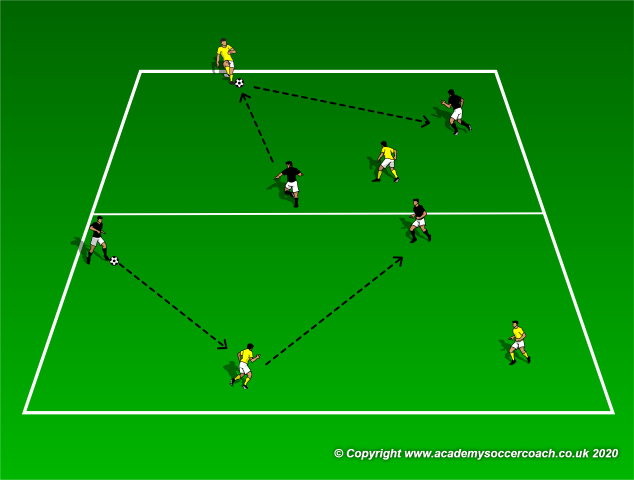
Rondo: 3v1 with different technical challenges.
Targeted outcomes: 1, 2, 3, 4 and 6.
Duration: 10 minutes.
Training load: 10 x 30” of work interspersed with 30” of rest.
Players: Four in each grid.
Area: Each grid measures 8 yards by 8 yards.
Description: Players play 3v1 keep-away using free touch. Vary this by introducing constraints such as playing with a two or one touch maximum.
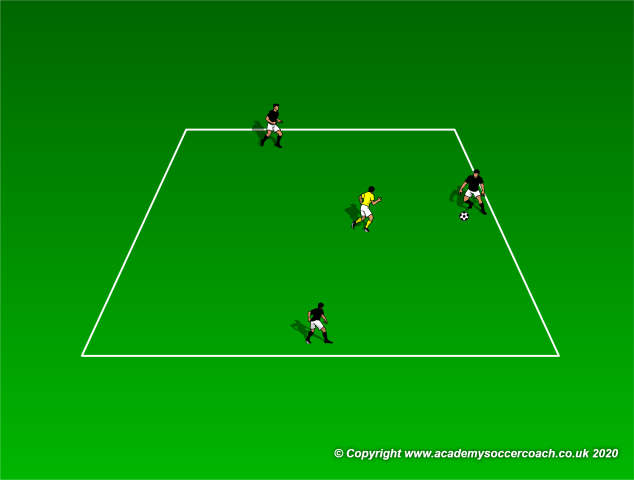
Positional play: 3v3+2.
Targeted outcomes: all.
Duration: 15 minutes.
Training load: Five series of two minutes each with one minute of rest in between.
Players: Two groups of three players each and two target players positioned at the end of each side.
Area: 20 yards by 12 yards divided into two equal zones.
Description: Both teams aim to keep possession of the ball for a pre-set amount of passes. Each team is aided with a neutral player at both ends. However, from the three players which they have, each team may only have a maximum of two players in each half of the area. Rotation of players (mobility) between zones is permitted.
Variation:
1. Remove the central line so to have only one zone. Watch the behaviour of the players in this variation! Are they continuously scanning the field before they receive the ball? Are they keeping the right distances from each other? Are they creating angles with each other?
2. Play as a directional game by having each team scoring by passing to a designated target player. Once the ball is played to the target player, the team keeps the ball and aims to pass to the opposite target player in order to score another point. The previous target player can however aid in retaining possession of the ball.
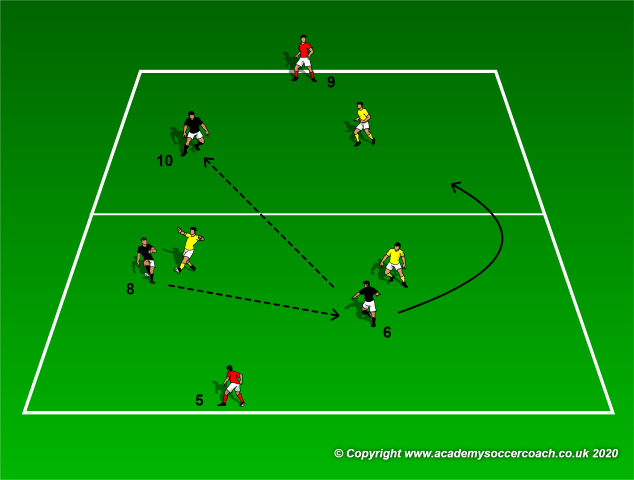
Game situation: 4v3+GK to 3v2 counter.
Targeted outcomes: 1, 2, 3, 4, 5 and 6.
Duration: 15 minutes.
Training load: Four series of three minutes each with one minute of rest in between.
Players: A goalkeeper plus three defenders and four attackers.
Area: 25 yards by 15 yards.
Description: The attacking team have two players inside the middle channel and a player on each flank zone. The three defenders stay inside the middle channel but may apply pressure on and tackle the attackers inside the flank zones. The flank players may cut inside to receive the ball behind the defenders as shown in the following diagram. The offside rule is in effect and it takes place from the centrally marked offside line. If the defenders win the ball they counter on the two mini goals in a 3v2 situation. The flank players do not defend.
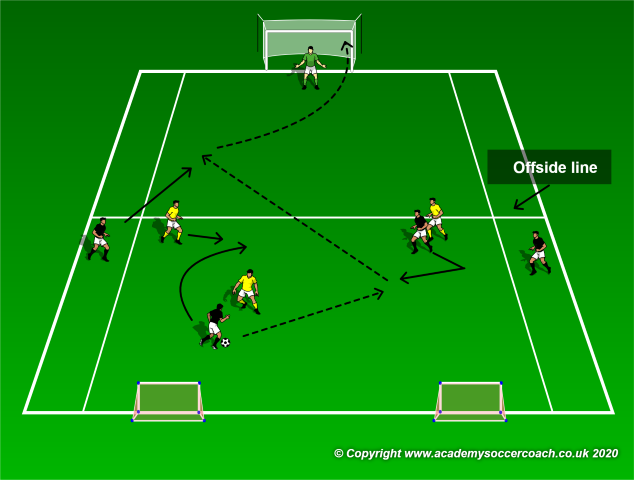
Reduced Game: 7+GKv7+GK.
Targeted outcomes: all.
Duration: 20 minutes.
Training load: Two series of eight minutes each with a two minute rest in between.
Players: Each team is composed of a goalkeeper, two central defenders, three midfielders and two forwards.
Area: 50 yards by 30 yards.
Description: According to the age and ability level of the players, the offside law may be applied. Normal soccer rules apply!
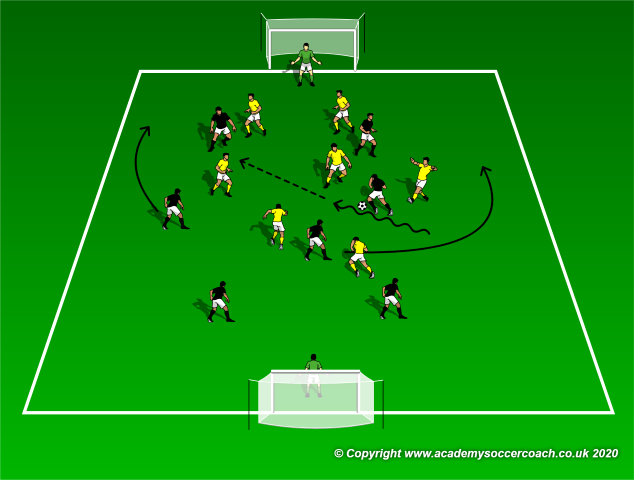
Cool down.
Pair players a have them experiment passing to each other using both feet, different surfaces of the foot and controlling the ball in the air. End the session with static stretching exercises. Total duration should be not more than 10 minutes.
By Philip Cauchi


